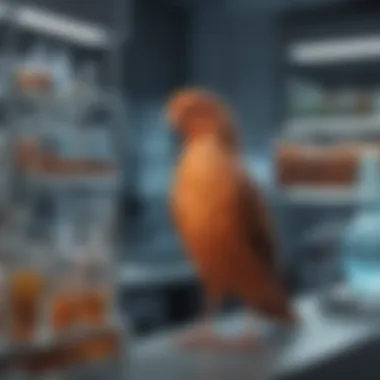Chick DNA Testing: A Comprehensive Guide


Intro
The field of poultry science is constantly evolving, with genetics playing a critical role in shaping the future of chick breeding and management. Chick DNA testing emerges as a pivotal tool within this domain, influencing various aspects from breeding techniques to health management. Understanding its implications and methodologies is essential for anyone involved in the avian industry, whether they're researchers, educators, or practitioners.
Research Context
Background and Rationale
The significance of chick DNA testing cannot be understated. This technology allows for the precise identification of genetic traits, which can enhance breeding programs by selecting for desirable characteristics such as disease resistance, growth rates, and egg production. With the poultry industry facing challenges such as outbreaks of diseases, the pressure to improve genetic diversity is immense. Therefore, having access to accurate genetic information is essential for making informed breeding decisions.
Literature Review
Current literature reveals a growing interest in avian genetics. Studies from various journals highlight the effectiveness of DNA testing methods. For instance, research indicates that genetic testing has led to advancements in marker-assisted breeding strategies. Furthermore, articles have discussed how these methods enable breeders to mitigate risks involved with inbreeding, thus promoting healthier populations. The integration of DNA-based approaches in poultry science has sparked discussions about its ethical implications and long-term impacts on the industry, which will be further explored in future sections.
Methodology
Research Design
In order to study chick DNA testing, a variety of research designs have been utilized. Experimental designs often include controlled trials where offspring are analyzed after being bred according to specific genetic traits. These designs provide invaluable insights into the effectiveness of DNA testing methods in real-world applications.
Data Collection Methods
Data collection in this realm typically comprises both qualitative and quantitative methods. Quantitative data can be gathered through DNA sequencing technologies, which reveal the specific genetic markers of various chick breeds. On the other hand, qualitative data often involves interviews and surveys with poultry breeders. These approaches together expand the understanding of how DNA testing can influence breeding practices and enhance overall flock health.
"Chick DNA testing serves as a bridge between traditional breeding practices and modern science, creating opportunities for innovation in the poultry industry."
As we delve deeper into this comprehensive guide, it is critical to explore not only the methodologies but also the real-world applications of chick DNA testing. How this knowledge is integrated into breeding strategies informs the future of poultry science.
Prelude to Chick DNA Testing
The significance of chick DNA testing lies in its potential to revolutionize poultry science. This field of study encompasses not just genetics, but also broader applications in agriculture and animal husbandry. DNA testing can improve the overall health and productivity of poultry. This section will delve into the definition, historical context, and current trends in chick DNA testing. By understanding these elements, readers can grasp the importance of this developing discipline.
Definition and Importance
Chick DNA testing refers to the analysis of genetic material in chickens to identify their hereditary traits. This testing provides crucial information about breed purity, potential health issues, and breeding compatibility. The information gathered can guide breeders in making informed decisions about which birds to pair. For instance, it can help predict offspring characteristics, such as growth rate and egg production. As a result, DNA testing enhances breeding programs, improves flock management, and promotes genetic diversity. This not only optimizes production but also supports sustainability in poultry farming.
Historical Context
The roots of genetic studies in poultry date back several decades. Initial efforts focused on traditional selective breeding, where specific traits were favored through manual selection. However, this approach often led to unwanted genetic bottlenecks and reduced diversity. With advances in molecular biology, the 1990s marked a shift to genetic markers and DNA analysis. This was a turning point, allowing researchers to study specific genes associated with desirable traits. Over time, the development of more sophisticated techniques has transformed chick DNA testing into a valuable tool for breeders and researchers alike.
Current Trends
Today, several trends are shaping the landscape of chick DNA testing. First, the adoption of non-invasive sampling methods, like feather and blood tests, has made the process easier and less stressful for the birds. Second, the integration of bioinformatics tools is facilitating data analysis, making it simpler to interpret complex genetic data. Furthermore, advancements in sequencing technologies, such as next-generation sequencing, are enabling detailed insights into the genome of various chicken breeds. Finally, there is a growing emphasis on the ethical use of genetic information, particularly in addressing concerns related to animal welfare and biodiversity preservation.
"Chick DNA testing is not just a scientific tool; it's a pathway to creating more sustainable poultry farming practices."
These current trends promise to enhance the efficacy of chick DNA testing and expand its applications in the field of poultry science.


The Science of DNA Testing
DNA testing in chicks represents a critical advancement in poultry science. It is the basis for understanding genetic make-up and its impact on various biological traits. By utilizing various methodologies, researchers can unlock data that helps in breeding, health assessments, and genetic diversity preservation.
Basics of DNA Structure
DNA, or deoxyribonucleic acid, consists of two strands forming a double helix. Each strand is composed of nucleotides, which include a phosphate group, a sugar molecule, and a nitrogen base. The order of these nitrogen bases—adenine, thymine, cytosine, and guanine—encodes genetic information. This structure is the foundation for understanding how traits are passed on and expressed in chicks. Knowing the DNA structure is fundamental for interpreting genetic results and their implications in breeding practices.
Techniques Used in DNA Testing
Various techniques in DNA testing contribute significantly to uncovering the genetic information essential for chick analysis. Three primary techniques include Polymerase Chain Reaction (PCR), Gel Electrophoresis, and Sequencing Technologies. Each technique has its specific applications and advantages.
Polymerase Chain Reaction (PCR)
Polymerase Chain Reaction, or PCR, amplifies specific DNA segments, making it easier to analyze small amounts of genetic material. A key characteristic of PCR is its ability to target particular sequences, enabling precise genetic analysis. This gives PCR a prominent place in chick DNA testing. The unique feature of PCR is its exponential amplification, allowing for the quick generation of enough DNA for testing. However, it can be costly and may require skilled personnel for accurate execution. Thus, while PCR is powerful, one must weigh the benefits against its complexity and potential costs.
Gel Electrophoresis
Gel Electrophoresis is a technique used to separate DNA fragments based on size. When an electric field is applied, smaller fragments move faster through the gel than larger ones. This makes Gel Electrophoresis beneficial for analyzing the results from PCR. Its unique feature lies in its ability to visualize separated DNA clearly, assisting in allele identification. One disadvantage, however, is that interpretation of the gels can sometimes be subjective, requiring experience to avoid errors.
Sequencing Technologies
Sequencing Technologies offer a comprehensive method to determine the exact sequence of nucleotides in a DNA segment. This technique is essential for detailed genetic analysis, allowing researchers to obtain information on individual genetic variation. A significant aspect of these technologies is their growing precision and efficiency, making them increasingly popular in genetic research. Although it can be more expensive and require advanced equipment, the insights gained are invaluable in advancing our understanding of chick genetics.
Applications of Genetic Analysis
Genetic analysis through DNA testing has several practical applications in the poultry industry. These include:
- Breeding Programs: Enhanced genetic understanding leads to better breeding decisions.
- Disease Resistance: Identifying genetic markers for disease resistance can help in developing robust chicken strains.
- Genetic Diversity: Monitoring genetic diversity is crucial in avoiding inbreeding and maintaining healthy populations.
The integration of these techniques not only improves our knowledge but also has far-reaching effects in practical applications in poultry science.
Benefits of Chick DNA Testing
Chick DNA testing plays a crucial role in modern poultry science. It encompasses various benefits that can dramatically improve genetic management and production within avian breeding efforts. Understanding these benefits can help farmers, researchers, and breeders utilize DNA testing effectively, leading to more responsible practices and better outcomes in poultry farming.
Enhanced Breeding Programs
The first significant benefit of chick DNA testing lies in its capacity to enhance breeding programs. Genetic profiling allows breeders to select parent chickens based on various genetic traits. This selection process can lead to poultry that exhibit desirable characteristics such as faster growth rates, improved egg production, and enhanced meat quality. By employing DNA testing, breeders can minimize issues related to inbreeding, thereby increasing overall flock vitality.
Using DNA information, breeding programs can incorporate specific traits that align with market demands. For instance, farmers could breed chickens that are better suited for organic farming or those that are more resistant to common poultry diseases. By doing so, this targeted selection increases the chances of successful outcomes, making breeding programs more economically viable.
Disease Resistance Assessment
Another critical advantage of DNA testing is its role in assessing disease resistance. Chickens are prone to various diseases, which can result in significant financial losses for farmers. DNA testing helps identify genetic markers associated with resistance to diseases like avian influenza and coccidiosis. By focusing on these markers, breeders can select birds that are naturally more resilient to disease, potentially reducing the need for antibiotics and other chemicals in poultry production.
An effective assessment of disease resistance not only preserves the health of individual birds but also contributes to flock-wide health. This leads to enhanced productivity and reduced mortality rates within livestock. Farmers can also implement more effective health management strategies by understanding the genetic susceptibilities present in their flocks.
Genetic Diversity Preservation


The preservation of genetic diversity is vital for the sustainability of poultry populations. Chick DNA testing plays an essential role in maintaining this diversity within breeding programs. By comprehensively assessing the genetic makeup of a flock, farmers can ensure that they are not overly reliant on a few genetic lines. This practice is essential as it mitigates the risks associated with inbreeding and related issues, such as reduced fertility and increased susceptibility to diseases.
Genetic diversity also enables the poultry industry to respond effectively to changing environmental demands and consumer preferences. This adaptability is crucial in a rapidly changing agricultural landscape, where climatic factors and market needs can shift unexpectedly. By actively managing genetic diversity through DNA testing, farmers can create more resilient and adaptable poultry stocks.
"The implementation of chick DNA testing is not just a technical advancement; it is a strategic necessity for the future of poultry farming."
In sum, the benefits of chick DNA testing are multifaceted. Enhanced breeding programs lead to better productivity, disease resistance assessment bolsters overall flock health, and genetic diversity preservation ensures sustainable practices. These factors collectively contribute to the advancement of poultry science, making it a critical area for careful study and implementation.
Ethical Considerations
The importance of ethical considerations in chick DNA testing cannot be overstated. This aspect of avian genetics not only shapes the practices in the poultry industry but also impacts the broader societal perception of genetic testing. As key advancements occur, discussions around ethics become critical. Strong ethical frameworks can promote animal welfare, ensure compliance with data privacy laws, and establish regulatory standards that govern the industry.
Animal Welfare Implications
Animal welfare is a central concern in any discussion related to genetic testing in chickens. The implications of DNA testing must be carefully weighed against the welfare of the animals involved. As breeding practices become more sophisticated, there is a risk that genetic interventions may inadvertently compromise the health and well-being of the chicks. High-density breeding for desirable traits can lead to health issues. Therefore, it is vital that any DNA testing protocols prioritize the overall health and quality of life of the chickens involved. Comprehensive welfare assessments should accompany testing processes to ensure humane treatment.
Such considerations include:
- Limiting inbreeding to prevent genetic disorders.
- Conducting regular health monitoring of breeding stock.
- Ensuring that the testing methods are minimally invasive.
Data Privacy Issues
With the rise in genetic testing, data privacy emerges as another critical ethical issue. Chick DNA testing creates valuable genetic data that must be handled responsibly. Farmers and researchers should be aware of the sensitive nature of genetic information and the potential misuse of such data. Establishing stringent data privacy protocols is essential to protect the interests of individuals and organizations involved.
Key aspects include:
- Obtaining informed consent from breeders and farmers.
- Implementing secure data storage solutions.
- Regularly reviewing data access policies to limit exposure.
"Ethics in genetic testing requires a balance between innovation and responsibility."
Regulatory Framework
The regulatory framework around chick DNA testing must keep pace with advancements in genetic technologies. Effective regulation can safeguard ethical standards while providing a structure for innovation. Regulatory bodies should clearly define guidelines for the use of genetic testing in poultry. This could include ethical guidelines for animal welfare, standards for data privacy, and protocols that govern the implementation of testing in breeding programs.
Such frameworks can promote:
- Transparency in testing processes.
- Accountability among stakeholders in the poultry industry.
- Ongoing review and refinement of ethical standards as technologies evolve.
In summary, ethical considerations are essential in the discourse on chick DNA testing. A focus on animal welfare, data privacy, and regulatory frameworks will help achieve responsible advancements in genetic testing. A thorough understanding of these ethical issues is necessary for students, researchers, and professionals involved in poultry science.
Challenges in Chick DNA Testing
Chick DNA testing presents distinct challenges that need careful consideration for effective application within the poultry industry. Understanding these challenges is crucial for researchers, educators, and practitioners. As the poultry science field evolves, the reliability and accuracy of genetic information become paramount. This section delves into three main challenges: technical limitations, interpretation of genetic data, and cost factors.
Technical Limitations
Technical limitations arise from the complexity of animal genetics. Various factors can influence the process, including the quality of samples and the technological capabilities of the testing methods. For instance, DNA degradation can occur if samples are not handled properly, leading to insufficient or compromised results.
Moreover, existing methods, such as Polymerase Chain Reaction (PCR) and sequencing technologies, can sometimes struggle to differentiate between subtle genetic variations. This can impact the assessment of trait inheritability, thereby complicating breeding decisions. The need for improved methodologies that can handle environmental effects on genetic expression is a pressing concern in this field.


Interpretation of Genetic Data
Interpreting genetic data is another significant challenge in chick DNA testing. Genetic information can be intricate, making it difficult to draw clear conclusions from the results. Misinterpretation may lead to misguided breeding strategies or improper assessments of genetic health. For instance, a researcher may wrongly identify a genetic marker associated with disease resistance, leading to ineffective breeding programs.
The ability to interpret genetic data accurately is integral to the success of DNA testing in agriculture.
Training in bioinformatics is essential for professionals in poultry science. The integration of statistical models can also enhance the validity of the conclusions drawn from genetic data, yet this requires specific expertise that might be lacking in some areas of the industry.
Cost Factors
Cost factors can significantly impact the implementation of DNA testing practices in the poultry sector. The expenses associated with advanced genetic testing technologies can be prohibitive for small to medium-sized farms. While the long-term benefits of improved bird health and productivity are evident, the initial investment remains a barrier for many potential users.
Moreover, the ongoing expenses related to sample collection, processing, and data analysis can accumulate quickly. If farmers and researchers cannot justify these costs through increased productivity or enhanced breeding strategies, the rate of adoption may remain low. Finding cost-effective solutions for genetic testing, without compromising quality, should be a focus for the industry moving forward.
Future Directions in Chick DNA Testing
The field of chick DNA testing is rapidly evolving, influenced by advancements in technology and increasing awareness of genetic implications in poultry science. Understanding future directions in this domain is crucial, as it will shape the methodologies that researchers and practitioners employ, ultimately benefiting the entire poultry industry. The exploration of innovative technologies, integration with existing software systems, and increased accessibility will dramatically enhance genetic testing practices.
Innovative Technologies on the Horizon
Emerging technologies are set to revolutionize chick DNA testing. Several innovations are already being developed to improve accuracy, efficiency, and accessibility of genetic information.
- Next-Generation Sequencing (NGS): This technology allows for comprehensive sequencing of avian genomes in a more cost-effective manner than traditional methods. NGS can provide insights into complex traits and allow for more precise breeding decisions.
- CRISPR-Cas9: Gene editing technologies like CRISPR are being researched to enhance disease resistance in chickens. This could drastically change breeding programs by allowing precise alterations to the genome.
- Bioinformatics: The integration of sophisticated algorithms to handle huge datasets generated by these technologies will be essential. This will enable researchers to draw more nuanced conclusions from genetic data.
As these technologies become more refined, they will likely increase the capacity for understanding genetic diversity and mitigating disease susceptibility.
Integration with Breeding Software
The incorporation of DNA testing technologies with breeding software is essential for optimizing poultry production. Modern breeding programs rely on software to analyze genetic data and make decisions. Integrating DNA testing results into these systems can enhance breeding efficiency.
- Real-Time Data Analysis: With integrated systems, farmers and breeders can instantly assess genetic information and make informed decisions during the breeding process.
- Predictive Modeling: Software can utilize genetic data to predict outcomes in breeding traits, optimizing selection processes to yield desired traits more reliably.
- User-Friendly Platforms: Simplified interfaces that allow farmers to easily access genetic information streamline the decision-making process. This ease of access empowers them to make swift decisions based on the latest genomic data.
Increased Accessibility for Farmers
For genetic testing to be truly beneficial, it must be accessible to farmers and breeders at all levels. Limiting access to expensive testing technologies can hinder progress in flock health and productivity.
- Cost Reduction: The ongoing development of simpler and cheaper testing methods will enable more farmers to utilize DNA testing in their practices.
- Awareness Campaigns: Educational initiatives can help farmers understand the importance of DNA testing. Increased literacy around genetic implications will drive demand for testing and enhance its application.
- Mobile Testing Kits: The introduction of portable testing kits can allow farmers to perform genetic tests on-site, increasing convenience and immediate access to information.
By focusing on these areas, the future of chick DNA testing shows great promise for improving overall poultry health and agricultural efficiency. As the industry evolves, the commitment to responsible practices and ethical considerations in testing and breeding will remain paramount.
Epilogue
The conclusion of this article emphasizes the critical role of chick DNA testing in modern poultry science. It serves as a capstone that integrates the various facets discussed throughout the article, showcasing the multifaceted benefits and implications of this technology. Advancements in genetic testing can potentially lead to enhanced breeding strategies, informed disease management, and sustained genetic diversity within poultry populations.
The Importance of Continued Research
Continued research in chick DNA testing is imperative. As techniques evolve, so too should our understanding and implementation of these methodologies. The ability to interpret genetic data accurately is crucial. Researchers must stay abreast of scientific advancements to refine existing processes and develop new solutions. A strong focus on research can lead to improved breeding programs and disease resistance assessments, ultimately benefiting poultry production on a global scale. Each improvement can reduce reliance on antibiotics and promote healthier bird populations.
Call for Responsible Practices
As with any emerging technology, the application of chick DNA testing must be approached with caution. Responsible practices should guide the implementation of genetic analysis to ensure that animal welfare is not compromised. This involves transparent communication about the benefits and risks associated with genetic testing. Stakeholders should prioritize ethical considerations, especially regarding data privacy and regulatory compliance. By fostering an environment of responsibility, all players in poultry science can contribute to the overall good of the industry, ensuring that advancements benefit both producers and consumers alike.
"The integration of genetic testing into poultry management is not just a scientific pursuit; it is also a social responsibility that impacts the ecosystem of agriculture."
In summary, the conclusion of this article is not merely a summary. It is a call to action for ongoing research and ethical practices in the realm of chick DNA testing. Emphasizing these elements enhances the overall framework for future research and implementation in this field.



